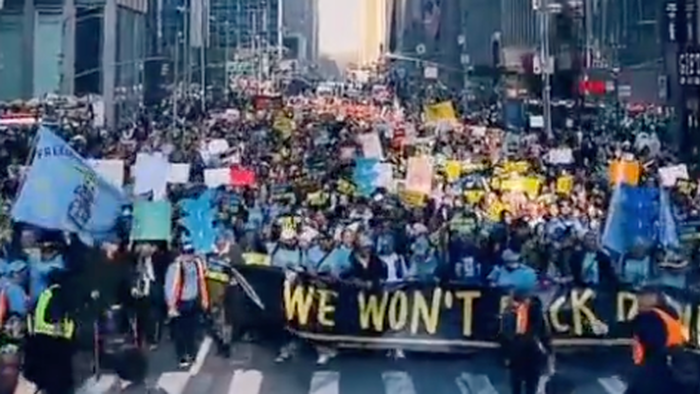Following the recent election of Donald Trump as the 47th President of the United States, Democratic activists have once again mobilized their extensive network of social justice warriors. This activation follows an early morning victory for Trump, leading to protests planned in New York City, gathering thousands of participants. Videos shared on social media platforms depict large crowds demonstrating in Midtown Manhattan, voicing their opposition to Trump’s policies, which they view as harmful to marginalized communities. Protesters chant slogans like “Racist, sexist, anti-gay,” aiming to shed light on issues they associate with systemic oppression, fascism, and heightened anti-immigrant sentiment following Trump’s electoral win.
The protests are characterized as well-organized and well-funded, a detail noted by various observers on social media, suggesting that the gatherings are not spontaneously arising grassroots movements but rather orchestrated efforts supported by non-profit groups funded by undisclosed donations. Alongside calls against deportations, which are central to Trump’s campaign promises, other themes arise, including demands for open borders and a rallying cry against Trump’s proposed sweeping immigration policies. Protesters include undocumented immigrants primarily from countries like Ecuador and Peru, actively voicing their opposition to what they view as an imminent threat to their safety and status in the U.S.
Recent protests have also surfaced in cities like Chicago, where demonstrators outside the Trump Hotel decried the President using slogans that had resonated during earlier electoral campaigns. In these settings, right-wing opposition rhetoric faced a revival, with protesters borrowing phrases typically reserved for imminent crises, aiming to combat perceived fascism from the highest office. Activists like Alexandria Ocasio-Cortez have publicly framed these protests as responses to a historical reawakening of authoritarianism, calling her followers to action against such political threats, while inciting fears of repression and government oppression.
Ocasio-Cortez’s rhetoric is viewed by some as an exhortation for her supporters to act, reigniting the narrative of dissent as a necessary and noble pursuit. She spoke on social media about the creation of movements meant to shield communities from threats posed by authoritarian governance, suggesting that the activism of the moment could reflect a broader resistance to a period of perceived dark governance ahead. This commentary has provoked mixed reactions, underscoring the polarization surrounding Trump’s presidency as opposition continues to organize effectively and show up in great numbers.
There is an ongoing argument regarding the motivations and methods of these protests. Some critics assert that the Democrat-led initiatives reveal a concerted and broad-based strategy to challenge Trump’s authority and marginalize his political influence swiftly. There are concerns that if the current trend of mobilization continues under Trump’s administration, the socio-political climate could rapidly escalate, with more entrenched divisions creating prolonged periods of unrest. Moreover, suggestions have emerged that under a Trump-led government, non-profit organizations that facilitate such activism may experience shifts in funding and operational capabilities, disrupting their ability to influence the political discourse.
As Americans witness the resurgence of these protests, the legitimacy of their grievances is questioned in the context of Trump having won the popular vote, leading to debates on whether these activist actions resonate with the wider public sentiment. With many Americans reportedly growing tired of ongoing activist demonstrations, the future of such protests may hinge on broader public opinion and the political climate fostered by the new administration. The interaction between activist movements, government policy, and citizen responses may set the tone for ongoing electoral strategy and civil change in the coming years.

